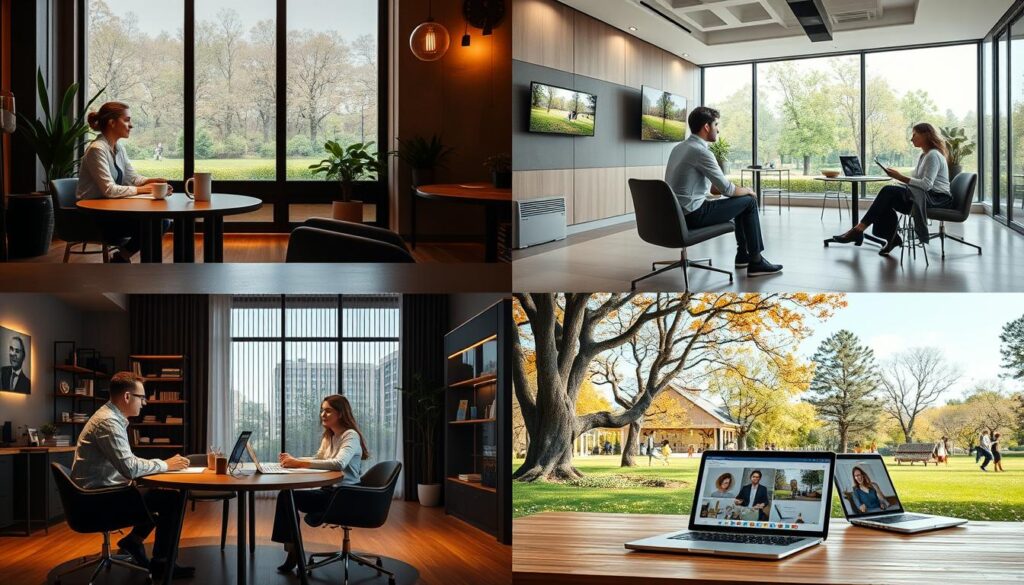“The key is to set realistic customer expectations, and then not to just meet them, but to exceed them – preferably in unexpected and helpful ways.” – Richard Branson
User interviews are a powerful tool for understanding how your customers interact with your products and services. They help you uncover valuable insights that drive product development and improve the user experience. This guide will teach you how to plan, execute, and analyze effective user interviews that deliver real results.
Key Takeaways
- User interviews provide deep, qualitative insights into customer behavior and preferences
- Interviews can cover a wide range of topics, from user background to product usage and pain points
- Conducting user interviews at key stages of the product lifecycle is crucial for informed decision-making
- Effective user interview techniques, such as open-ended questions and building rapport, are essential for gathering high-quality data
- Analyzing user interview data to identify patterns and themes can lead to significant product improvements
Why User Interviews Are Essential for Product Development
User interviews are a key tool for understanding user needs and gaining valuable insights. They help improve product success. These conversations dive deep into users’ experiences and what they want.
Understanding User Needs
User interviews are different from other research methods. They focus on learning new things about users. This direct interaction helps teams find out what users really need.
Gaining Valuable Insights
User interviews give teams rich, qualitative data. This data helps guide design decisions. Observing users’ body language and tone adds depth to this understanding.
Improving Product Success
Conducting user interviews at various stages is crucial. They help ensure products meet user needs. This feedback loop reduces the risk of creating something users won’t like.
In today’s competitive world, user interviews are vital. They help teams create products that solve problems and delight customers. Using user interviews in development leads to product success.
Preparing for User Interviews
Getting ready for user interviews is crucial. Before starting, set clear goals about what you want to learn. These research goals will guide your interview plan. They help you get the insights needed for user-centered design.
After setting your goals, create a detailed target user profile. This profile should match your existing user personas. It ensures you talk to the right people, giving you valuable feedback.
| User Interview Format | Percentage of Researchers |
|---|---|
| One-on-one, in person | 70% |
| Video call | 65% |
| Phone call | 45% |
With your goals and profiles ready, start interview preparation. Make a detailed interview guide with open-ended questions. Test your guide first to make any needed changes. Also, pick a good location for the interview, making sure it’s comfortable and neutral.
“User interviews are essential for understanding user experience and usability. They can reveal insights about user preferences, thoughts, and feelings that are crucial for aligning business decisions with user needs and expectations.”
By preparing well for your user interviews, you’ll get the insights needed. These insights will help drive your user-centered design efforts. You’ll create products that really connect with your audience.
Crafting Effective Interview Questions
When doing user experience research, it’s key to ask the right questions. The questions you choose can greatly affect your interviews’ success. Use open-ended questions to let users share their experiences fully. This way, you get insights that help improve your product and make users happier.
Types of Questions to Ask
Begin with open-ended questions that let users share their thoughts and feelings. Use descriptive, comparative, and causal questions to understand user needs better. Avoid leading questions that might influence answers. Use follow-up questions to get more details.
Avoiding Leading Questions
Be careful with how you phrase your questions to avoid bias. Leading questions, like those with “because,” can influence answers. Also, avoid compound questions that mix too many ideas. Keep your questions simple and open-ended.
Keeping it Conversational
The goal of user interviews is to keep it friendly and relaxed.
“Building rapport and trust with participants is essential for eliciting honest and insightful feedback.”
Don’t sound too formal or like you’re interrogating them. Try to make the atmosphere welcoming. This way, you can gather valuable insights that help improve your product.
Selecting the Right Interview Format
Choosing the right interview format is key to getting good insights. Think about what you want to learn, who you’re talking to, and what you can do. This helps pick the best way to talk to people.
One-on-One Interviews
One-on-one interviews let you really get to know someone. You can ask deep questions and learn a lot. This is great for understanding what users really need.
Focus Groups
Focus groups are good for hearing many views at once. They’re great for seeing what lots of people think. This helps find common ideas and trends.
Remote vs. In-Person
Remote interviews are easy to set up and reach more people. But, in-person talks let you see body language and connect better. Think about what you need for your research and who you’re talking to.
| Interview Format | Advantages | Disadvantages |
|---|---|---|
| One-on-One Interviews |
|
|
| Focus Groups |
|
|
| Remote Interviews |
|
|
| In-Person Interviews |
|
|
When picking an interview format, think about what you want to learn and who you’re talking to. The best choice depends on your research goals and who you’re interviewing.

Recruiting Participants for Interviews
Starting successful user interviews means finding the right people. For participant recruitment, look for those who fit your target user profiles well. This way, the insights you get will truly represent your audience.
So, where do you find these valuable participants? Begin with your friends, current customers, or even street interviews. Also, using paid services can open up a wider, more varied group of people.
Offering Incentives
To get people to participate, offer interview incentives. You can give gift cards, cash, product samples, or special access. Studies reveal that over $32.5M in incentives have been given out. Plus, 99% of sessions got positive feedback, with fraud under 0.3%.
Ensuring Diversity
It’s key to have a diverse group of participants. This way, you get insights from many different viewpoints and experiences. The data shows the User Interviews database has 140 industries, 73,000 occupations, and 230,000 business owners. It covers 8 countries and all 50 U.S. states.
By using good recruitment methods, offering great incentives, and focusing on diversity, you’re ready for interviews. These will give you the best insights to improve your product.
Conducting the Interview
Successful user interviews need a comfy setting where people feel free to share their real thoughts. As UX researchers, we aim to connect well with our interviewees. This way, we gather insights that help shape our products. By creating the right vibe and using smart interview techniques, we get lots of useful data.
Setting the Right Environment
The interview’s setting is key for open talk. Pick a quiet, distraction-free spot where people can focus. Make sure the seating is cozy, not stiff, to help everyone relax. Also, keep the room’s temperature, lighting, and background noise just right.
Building Rapport with Participants
Building rapport is vital for trust and openness. Begin with some easy chat to ease them in. Ask open-ended questions and listen actively. Use nods and eye contact to show you’re really listening. Think of it as a friendly chat, not an interrogation.
Taking Notes and Recording
To catch all the data collection moments, have two people – one to talk and the other to note-take. If okay with the participant, record the session too. This way, you can fully engage in the user research without missing anything important.
By setting the right mood, building rapport, and carefully noting the interview, you can gather lots of user insights. The aim is to make everyone feel at ease, so they can share honestly and openly.
Analyzing User Interview Data
After doing user interviews, the real value is in analyzing the data. This helps us find patterns and themes. We learn valuable UX insights that guide important product choices.
Immersing ourselves in user stories is key. These are real-life tales that show what our users need and struggle with. They help us understand and act on the research findings.
We use charts and diagrams to share our findings clearly. This makes it easy for others to see the main points. They can then make data-driven decisions about what to improve in our product.
Identifying Patterns and Themes
We find common threads by coding and categorizing user responses. This data analysis uncovers insights that might not be obvious at first glance.
Utilizing User Stories
User stories make the data come alive. They make it easier for stakeholders to connect with our findings. These stories show the specific challenges and goals of our users.
Presenting Findings
The last step is to present our findings in a clear way. We might write a detailed research report. It should outline our methods, key findings, and suggestions for product betterment. Presenting our data analysis and user stories well is key to making a real impact.
“Effective analysis of user interview data is the foundation for creating products that truly delight our customers.”
Applying Insights from User Interviews
User interviews give us valuable insights. But it’s how we use these insights that really matters. We can make better decisions, improve our products, and see how we’re doing. This way, we can make solutions that our users will love.
Making Data-Driven Decisions
User interviews give us lots of information. We can find patterns and understand what users need. Data-driven design means we make changes based on real user needs, not just guesses.
Iterating on Product Features
Insights from interviews help us improve our products. We learn what users like and what they don’t. This helps us focus on the right features and make our products better.
Tracking Progress
We don’t stop listening to users after we launch. We need to keep hearing from them to see if we’re doing well. This way, we can always make our products better for our users.
User interviews are key to making products that users love. By focusing on what users need, we can solve real problems and give them a great experience. This way of working is essential for making products that last.
Common Mistakes to Avoid in User Interviews
User interviews are key in product development. But, it’s easy to make mistakes that can harm your insights. To get valuable results, avoid these common pitfalls.
Skipping Preparation
Good preparation is the base of a successful user interview. Not setting clear goals or creating a user profile can make the interview awkward. It also wastes time and makes it hard to connect with participants.
Overloading on Questions
It’s tempting to ask lots of questions to get all the info. But, asking too many questions can confuse participants. Instead, ask one open-ended question at a time. This lets the conversation flow naturally.
Ignoring Feedback and Insights
User interviews are not just for confirming what you think. They’re a chance to find new feedback and insights. Stay open-minded and analyze the data carefully. This helps make decisions that really meet user needs.



